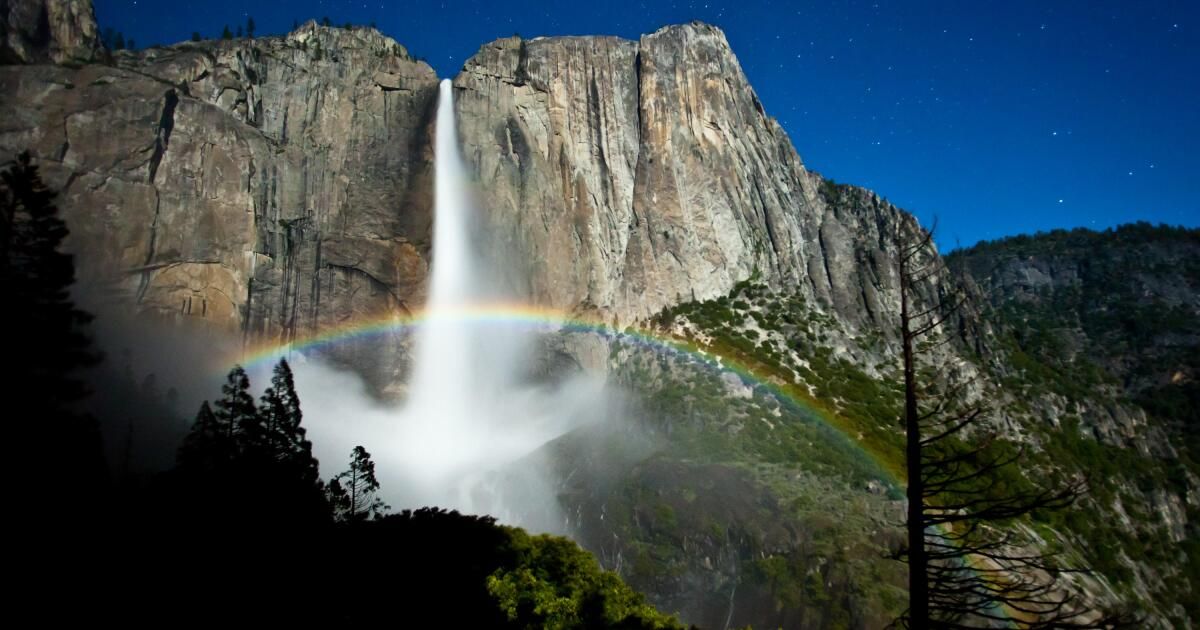We met Brian Hawkins, a mechanical engineer turned videographer from Redondo Beach, in the nearly empty lobby of the Yosemite Valley Lodge. It was just after 9 pm on a Tuesday at the end of April. Our hunt was about to begin, but the weather did not bode well.
“It's cloudy, it will clear up later,” he said. “I wouldn't expect to see anything yet.”
This was not a chance meeting. A couple of years earlier he had discovered Hawkins' website, where he posts photos, videos and very accurate predictions of the phenomenon that had drawn us to this place, exactly at this moment: the lunar arcs.
Naturalist John Muir called them lunar rainbows, or spray arcs, revealed by the light of the full moon. The roaring spring and early summer waterfalls in Yosemite National Park make the central California destination one of the few places on Earth to see them. The next viewing opportunity is May 21-25.
Moonbows hasn't realized the popularity of the park's firefall each February, but visitors are gaining awareness. As we walked the paved trail in the dark toward Lower Yosemite Fall, we passed groups of hikers heading in the other direction, evidently discouraged by the lingering clouds. At the base, about 25 people were gathered in small groups, many of them behind a curve to protect spectators from the falls' strong spray.
Muir described the roar of Yosemite Falls as “fine, wild music,” and Hawkins spoke movingly of how the falls, especially in the upper reaches, maintained a voice, even a presence. Having seen spectacular photographs of him and others, my wife Mica and I waited impatiently for the moon to reflect sunlight off the falls. As others did.
Brian Hawkins, left, encountered Richard and Sally Brewer and Anne Johnston-Fera of Buffalo, New York, searching for moonbows in April in Yosemite's Cook's Meadow.
(Alex Pulaski)
A photographer showed me an image of a quarter arc lunar he had captured 20 minutes earlier during a break in the clouds. Another, Eric Krapil, 28, of Laurel, Maryland, shared a full-arc moonbow photo from the night before, captured on his cell phone.
“We were lucky,” he said. “A guy who walked past us at the hostel said, 'Do you want to see a moonbow?'”
We certainly did tonight. And a few minutes later, as the yellowish moon appeared briefly through the haze, Hawkins pointed to a rock. There, he said, begins a corner of the lunar arc.
And I saw it: a quarter arch at best, ghostly white in the dim moonlight. It wasn't everything I'd hoped for, but as we drove back later I thanked Hawkins for helping us see that flash, a hint of what might happen in the nights ahead.
Yes, he said. She followed a thoughtful pause.
“That was,” he continued, “the most pathetic moonbow I've ever seen.”
Before 2007, no one was sure when and where lunar arcs would appear in Yosemite. But a team of researchers at Texas State University used computers to combine topography, geometry and astronomy to accurately predict the appearance of lunar arcs and published their findings.
Hawkins visited the park for the first time that same year and was mesmerized by its beauty, particularly after seeing a moon arch in 2011. He began doing his own modeling and his website debuted in 2018. It's a labor of love – there are no ads and He doesn't tour or sell t-shirts.
What it does is help other search engines. Anna Smits, who lives and works in Yosemite Valley, saw her first moonbow during the pandemic. The park was closed to visitors, but Hawkins still shared her calculations. Now, Smits, an avid photographer and nature lover, occasionally goes further afield to find more elusive moonbow shots.
What does that involve? One night, that involved setting an anchor and rappelling about 15 feet to a ledge near Upper Yosemite Fall. On another occasion, he set the alarm for 1:30 a.m. for a bright moonlight hike to Vernal Fall. It was so cold that the condensed spray froze her tripod solid.
“It's a very rewarding experience,” he said. “It really lights me up just thinking about sitting in the dew and watching this lunar arc cross in front of you.”
That visual reward eluded us on the following two nights of our visit last month. The blue skies during the day gave way to clouds at night. Hawkins had warned me that first night that nothing was guaranteed.
“Prepare to be captivated by the scene before you, but also frustrated by how difficult it is to film,” he said. “Many things work against you: it's cold, it's wet, you have to dry the lens and you can't use autofocus. You just have to be patient and work to solve all the problems.”
And when the moon is hidden behind a curtain of clouds, you comfort yourself with the memory of the voice of the falls and a glimpse of the spectacle that awaits you upon your return.
What is a moonbow?
Simply put, it is a rainbow seen at night, produced by the light of the full moon reflecting off water droplets suspended in the air. But humans have a hard time detecting color at night, so, like the northern lights, they often appear white to the naked eye. Photographs, especially with timed exposures to allow more light, show them in full color, like a rainbow.
Is Yosemite the only place to see moon arches?
No, but there are very few places where you can see waterfalls constantly. They include Cumberland Falls in Kentucky and Victoria Falls in Africa, on the border between Zambia and Zimbabwe.
When are the best dates, times, and places to see the Yosemite Moon Arches?
They are best observed during the five nights around the full moon. Hawkins has calculated 2024 peak viewing dates and location-specific times (Upper and Lower Yosemite Falls and Glacier Point) for the upcoming May 21-25 viewing window on his website. The best dates for the next full moon, and timing calculations will be made later, are June 19-23.
Is any special equipment needed?
Helpful items include comfortable walking shoes, a rain poncho if you're looking near the base of a drop, cloths for drying lenses and cameras, a tripod for longer camera or smartphone exposures, and a headlamp or flashlight ( red light setting is preferable so as not to disrupt night vision). . Weather apps like Clear Outside predict cloud cover every hour. For the more advanced, apps like Photo Ephemeris and Planit Pro will help accurately calculate moon positions (and much more).
Are reservations required in Yosemite National Park?
Sometimes. Through June 30, daytime park entry reservations are required (5 a.m. to 4 p.m.) on weekends and holidays. From July 1 to August 16, they are required daily for the same time periods. Those with lodging or camping reservations within the park will be allowed entry to the park. Complete rules and a reservation link can be found on the National Park Service website.
Is it risky to look for moon arches in Yosemite at night?
We don't find it discouraging. Lower Yosemite Fall is just a 10-minute walk from Yosemite Valley Lodge, where we stayed. Cook's Meadow, with its expansive view of Yosemite Falls, is also nearby, but we decided to drive, largely because heavy cloud cover obscured the moonlight. Both Hawkins and Smits advised using common sense when looking for more remote locations. It is worth noting that the intrepid Muir, who never shied away from a challenge, was nearly killed one night while chasing moonbows behind Yosemite Falls near Fern Ledge; he escaped soaked and numb from a “wild bath in the moonlight.”










